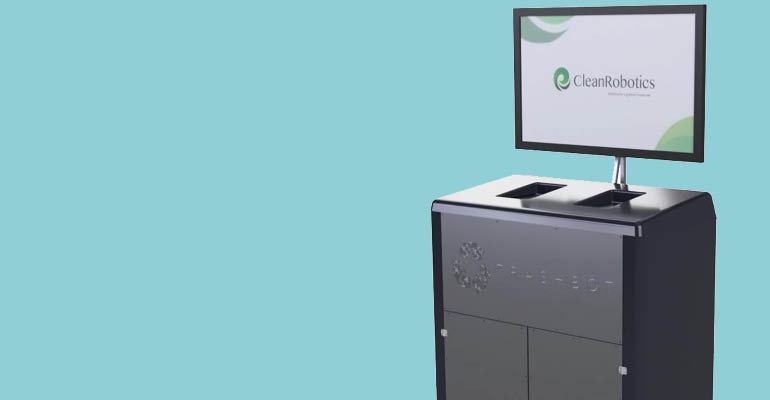Waste360 recently sat down with Cook to discuss the technology behind the Trashbot and its future in the waste and recycling industry.

While recycling is near ubiquitous in the United States, the rules about what goes into the bin (or bins) varies greatly depending on the municipality. On top of that, the rules within municipalities often change as new bins are introduced or nearby MRFs are upgraded.
This leads to constant confusion about what should be thrown into bins and, ultimately, higher rates of contamination in recycling streams.
But one Pittsburgh-based company, CleanRobotics, is looking to take the human error out of the process by developing a self-sorting can powered by artificial intelligence. This Trashbot separates recyclables as they’re tossed into a bin. It also monitors waste streams and analyzes what is being disposed.
“CleanRobotics was founded two years ago by a team passionate about the environment who perceived a massive issue,” says Tanner Cook, co-founder and vice president of engineering for Clean Robotics. “Since then we have been through the HAX and AlphaLab Gear Accelerators, built numerous prototypes, and are planning on going into full scale production in a few weeks.”
Waste360 recently sat down with Cook to discuss the technology behind the Trashbot and its future in the waste and recycling industry.
Waste360: How does the Clean Robotics Trashbot work?
Tanner Cook: Trashbot utilizes a variety of sensors, robotics and artificial intelligence (AI) in order to detect what a piece of waste is, classify it as recyclable or not, then separate the item into the correct receptacle.
By combining robotics, sensor technology and the Cloud, Trashbot not only categorizes your unwanted materials, it can audit your waste generation, let you know when it’s full, and can be wirelessly updated if there is a change in your community’s recycling program.
Trashbot has a single opening for all trash. Simply walk up to a Trashbot (programmed specifically for the municipality you’re in) and toss your garbage into the open chamber. The lid closes and you walk away. Once the item is inside, a combination of cameras and sensors quickly scan the type of discarded material. Using a custom machine-learning algorithm, Trashbot then makes a classification.
A mechanical flap system deposits the item into either the single stream recycling bin or landfill waste. A weight sensor then keeps track of the amount of recyclable material and landfill waste on a daily/weekly basis for accurate waste auditing; a particularly helpful feature for businesses who perform waste monitoring and/or those with green initiatives.
Waste360: What are the benefits of this robot to the waste and recycling industry?
Tanner Cook: It massively improves the quality and quantity of recyclables for single stream recycling. Trashbot can also do instantaneous, high resolution trash audits in order to let facilities and municipalities know the composition of the waste.
The more waste collected by Trashbots, the better. Trashbot’s sorting accuracy is designed to improve over time as it learns to detect more and more types of materials. Data from Trashbot’s first pilot at a technology company in Pittsburgh showed results of 81 percent sorting accuracy after only very basic training.
Waste360: What are some of the challenges Clean Robotics has faced in getting this robot launched?
Tanner Cook: Designing a robust and durable robot that contained all of our technology took some time and we are constantly working to improve upon our designs.
Waste360: What waste handling applications are now possible with this technology?
Tanner Cook: Currently we don't have any integrated (organic applications) as Trashbot just sorts into landfill and recycling. We are designing our next version to separate out compostables, though we will not compost on site.
A single Trashbot has the potential to replace all conventional trash and recycling bins we currently use. With accurate, automated separation of recyclables at the source, communities could even begin utilizing multi-stream recycling instead of single stream.
Waste360: Have any North American companies/organizations purchased the Trashbot? If so, which ones?
Tanner Cook: Unfortunately these companies have asked us to keep quiet about their participation, but they are large companies in everything from tech to convention centers. So far everyone in the Industry is incredibly excited about it. There are massive sunk costs to separating recyclables by hand and using current technology, so Trashbot provides a useful and cost-effective service.
About the Author(s)
You May Also Like


